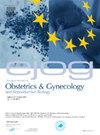通过 DuoStim 进行多周期治疗有利于治疗适用 PGT-M 加 PGT-A 的夫妇。基于倾向得分匹配的病例系列
IF 2.1
4区 医学
Q2 OBSTETRICS & GYNECOLOGY
European journal of obstetrics, gynecology, and reproductive biology
Pub Date : 2024-11-04
DOI:10.1016/j.ejogrb.2024.11.003
引用次数: 0
摘要
目的比较 DuoStim 与传统方法在单基因和非整倍体植入前遗传检测(PGT-M + PGT-A)患者中的应用。在 5 年中,132 对夫妇接受了 PGT-M + PGT-A,并在第一次取卵后获得了≤5 个囊胚。其中 55 人接受,77 人选择标准方法。采用倾向分数匹配法产生了两个匹配组,每组 41 名患者。主要结果是每对夫妇在第一次取卵后 1 年内的累积活产率(cLBR)。在传统方法组中,85%的患者在第一个周期失败后中止了治疗(N = 28/33,95 %CI:69.1-93.4%)。使用 DuoStim 后,16 对夫妇有≥ 1 个健康的 LB(1 年 cLBR:39%,95%CI:25.7-54.3%),19% 的夫妇在单胎妊娠后分娩了 2 个健康的婴儿(N = 3/16,95%CI:6.6-43%),68% 的夫妇有多余的可转移囊胚(N = 11/16,95%CI:44.4-85.8%)。在对照组中,9 对夫妇获得了健康的 LB(1 年 cLBR:22%,95%CI:12.0-36.7%),只有 1 对夫妇有多余的可移植囊胚。总体而言,选择 DuoStim 的夫妇获得了 3.9 ± 2.5 个囊胚,其中 1.2 ± 1.3 个可移植,而选择传统方法的夫妇获得了 2.3 ± 2.1 个囊胚,其中 0.8 ± 1.0 个可移植。尽管如此,还需要更大规模的前瞻性研究。此外,应进一步验证将阈值设定为 5 个囊胚是否合适。本文章由计算机程序翻译,如有差异,请以英文原文为准。
A multi-cycle approach via DuoStim is beneficial to treat couples indicated to PGT-M plus PGT-A. A propensity score matching-based case series
Objective
To compare DuoStim versus a conventional approach in patients indicated to Preimplantation-Genetic-Testing for both monogenic conditions and aneuploidies (PGT-M + PGT-A).
Study design
Retrospective case-control study. In 5 years, 132 couples indicated to PGT-M + PGT-A who obtained ≤5 blastocysts after a first retrieval were suggested to undergo a second stimulation in the same ovarian cycle. Of them, 55 accepted, while 77 preferred the standard approach. Propensity-Score-Matching method was adopted to produce two matched groups of 41 patients per arm. The primary outcome was the cumulative-live-birth-rate (cLBR) per couple within 1 year from the first oocyte retrieval.
Results
In the DuoStim arm, 100 % of the patients underwent two ovarian stimulations. In the conventional approach group, 85 % discontinued the treatment after a failed first cycle (N = 28/33, 95 %CI:69.1–93.4 %). After DuoStim, 16 couples had ≥ 1 healthy LB (1-year cLBR: 39 %, 95 %CI:25.7–54.3 %), 19 % of them delivered 2 healthy babies after singleton pregnancies (N = 3/16, 95 %CI:6.6–43 %) and 68 % have surplus transferable blastocysts (N = 11/16, 95 %CI:44.4–85.8 %). In the control, 9 couples obtained a healthy LB (1-year cLBR: 22 %, 95 %CI:12.0–36.7 %), and only 1 have surplus transferable blastocysts. Overall, couples opting for DuoStim obtained 3.9 ± 2.5 blastocysts of which 1.2 ± 1.3 transferable, while couples opting for the conventional approach obtained 2.3 ± 2.1 blastocysts of which 0.8 ± 1.0 transferable.
Conclusions
DuoStim may minimize treatment discontinuation and increase the probability to obtain transferable blastocysts in the studied population. Nevertheless, larger prospective studies are required. Also, the suitability of a threshold set at 5 blastocysts should be further validated.
求助全文
通过发布文献求助,成功后即可免费获取论文全文。
去求助
来源期刊
CiteScore
4.60
自引率
3.80%
发文量
898
审稿时长
8.3 weeks
期刊介绍:
The European Journal of Obstetrics & Gynecology and Reproductive Biology is the leading general clinical journal covering the continent. It publishes peer reviewed original research articles, as well as a wide range of news, book reviews, biographical, historical and educational articles and a lively correspondence section. Fields covered include obstetrics, prenatal diagnosis, maternal-fetal medicine, perinatology, general gynecology, gynecologic oncology, uro-gynecology, reproductive medicine, infertility, reproductive endocrinology, sexual medicine and reproductive ethics. The European Journal of Obstetrics & Gynecology and Reproductive Biology provides a forum for scientific and clinical professional communication in obstetrics and gynecology throughout Europe and the world.

 求助内容:
求助内容: 应助结果提醒方式:
应助结果提醒方式:


